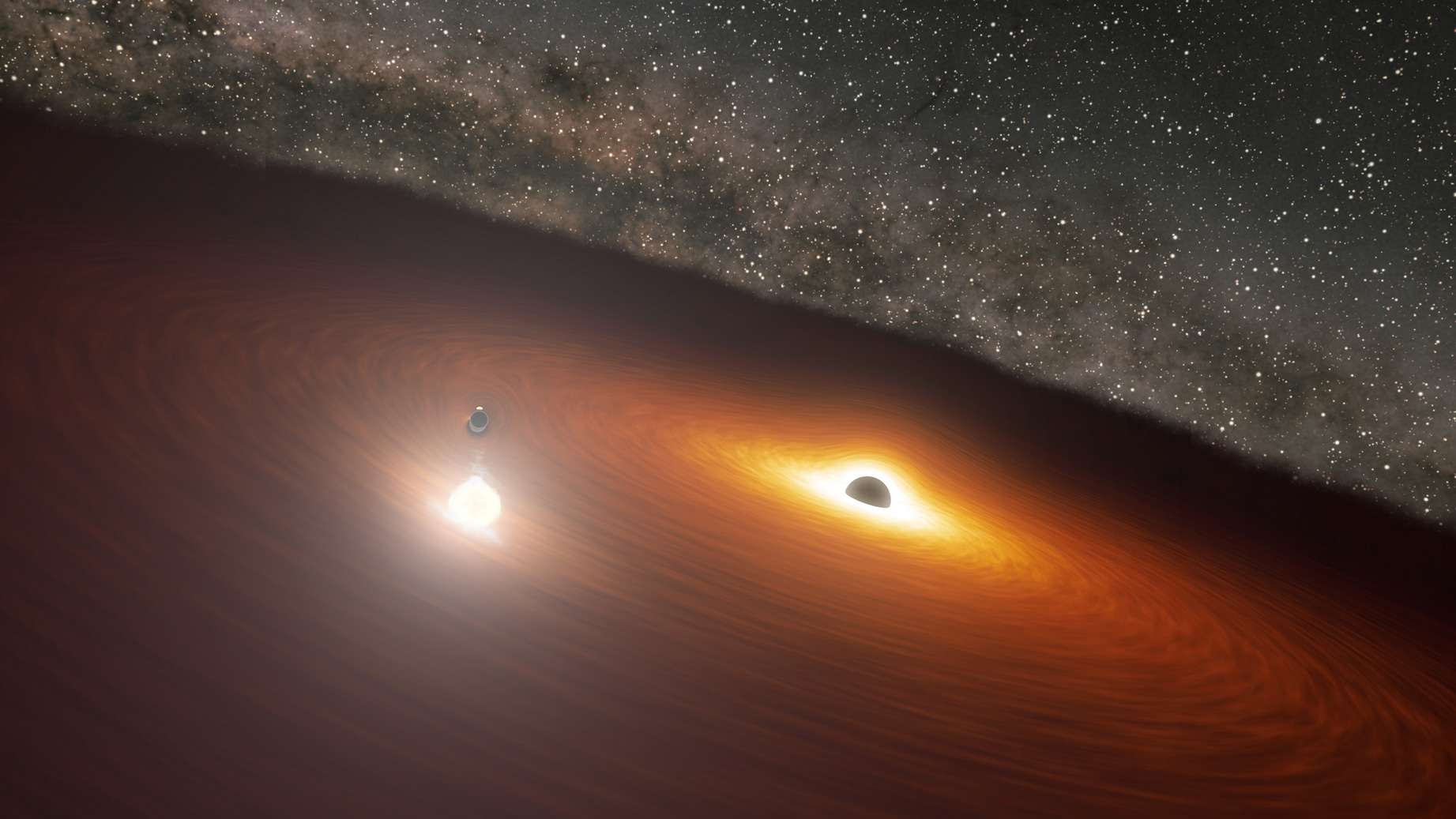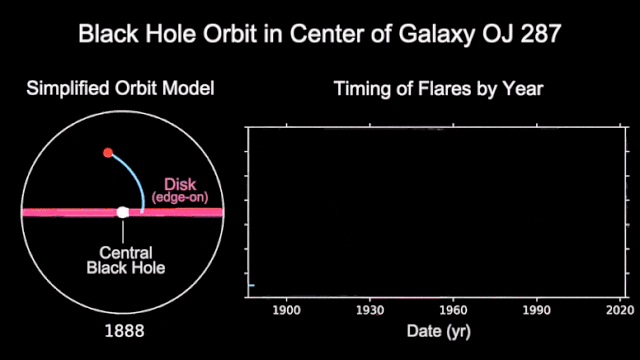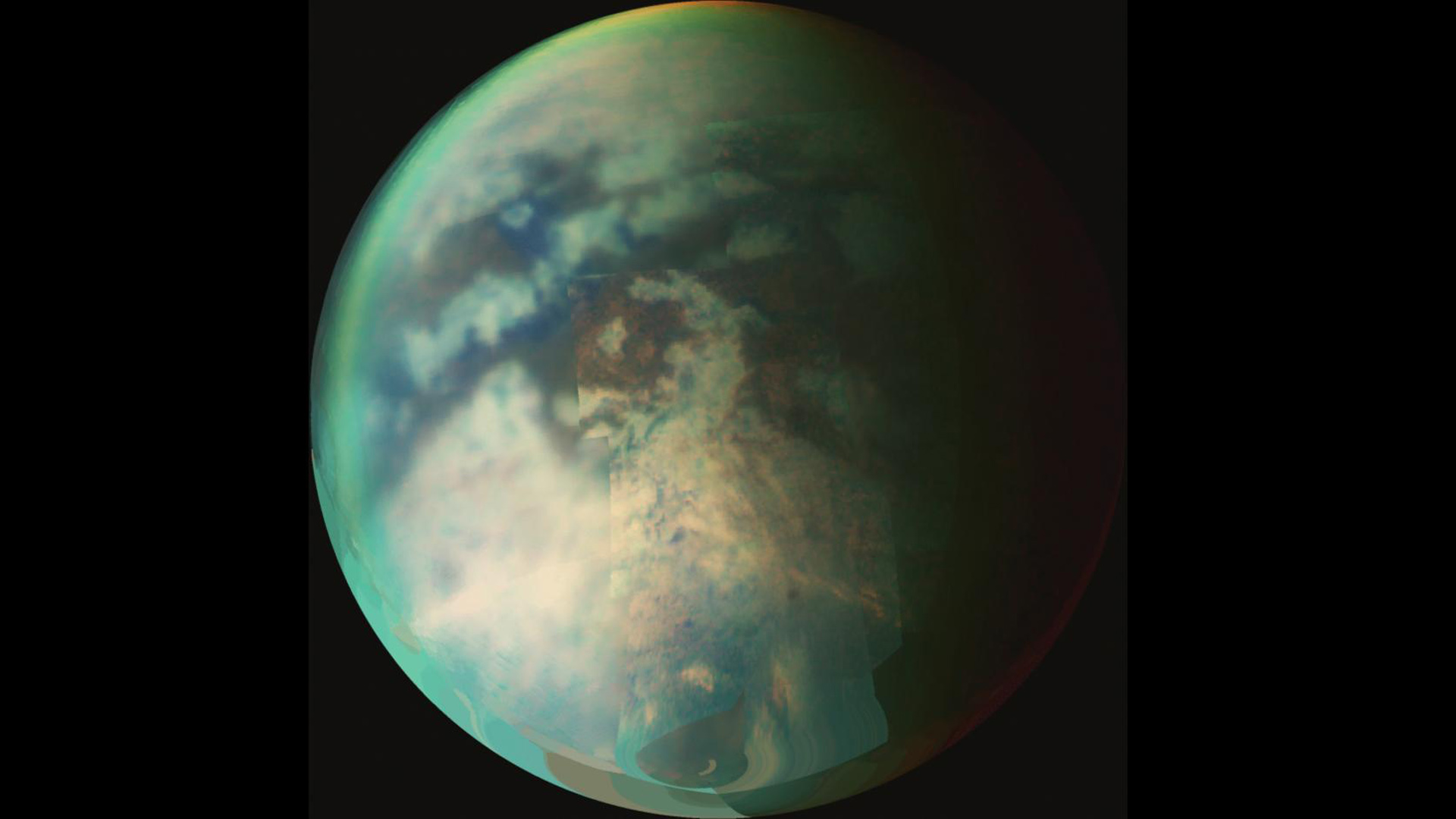Flashy 'dance' of two monster black holes captured by NASA's Spitzer Space Telescope
If two black holes tango in space but astronomers cannot see them, can we still admire their flashy dance moves?
Because black holes have such a strong gravitational pull that not even light can escape, they can't be observed directly and are therefore difficult to study. But one pair of black holes has enamored astronomers with a complicated celestial dance that periodically produces extremely bright flashes of light — outbursts that are brighter than a trillion stars and even the entire Milky Way galaxy.
By studying the timing of these bright flashes of light, researchers have attempted to map out the complex choreography of the black holes' movements and predict exactly when the system will flare up again. After more than 120 years of observations and decades of building computer models, astronomers have finally figured out what these black holes are up to, thanks to data from NASA's now-retired Spitzer Space Telescope.
Video: Black Hole pair produce flares 'brighter than 1 trillion stars'
Related: Spitzer's greatest exoplanet discoveries of all time
The two "dancing" black holes are located 3.5 billion light-years from Earth at the center of a galaxy called OJ 287. The larger of the two is one of the biggest black holes ever found, weighing in at more than 18 billion times the mass of the sun. Orbiting around this big black hole is a much smaller black hole that's about 150 million times the mass of the sun. Twice every 12 years, the smaller black hole passes through the larger one's accretion disk, or the flat band of dust and gas falling into the black hole, creating brilliant flares of light.
Because the small black hole's orbit is irregular — its position shifts with each 12-year loop around its partner — these flashes don't occur on a regular schedule. Sometimes they might occur just one year apart, while other times up to a decade passes between flares. The seemingly random timing of the flares has made it difficult for astronomers to figure out exactly what kind of "dance" these black holes are doing.
One computer simulation in 2010 was able to predict the flares within one to three weeks. In 2018, another group of researchers led by Lankeswar Dey, a graduate student at the Tata Institute of Fundamental Research in Mumbai, published a new model that they claimed could predict the flares' occurrence within four hours. In a new study, published Tuesday (April 28) in The Astrophysical Journal Letters, Dey's group reports that Spitzer's observations of a flare on July 31, 2019, confirm that their model is correct.
Breaking space news, the latest updates on rocket launches, skywatching events and more!
The Spitzer Space Telescope, which NASA decommissioned in January, just happened to be in the right place at the right time to observe the flare on that day, when no other telescopes on Earth or in space were able to see it. At the time, OJ 287 was on the opposite side of the sun from Earth's perspective.
Spitzer was 158 million miles (254 million kilometers) away from Earth at the time, and from its vantage point the telescope had a clear view of OJ 287 for a little over a month, from July 31 to early September, NASA officials said in a statement.
"When I first checked the visibility of OJ 287, I was shocked to find that it became visible to Spitzer right on the day when the next flare was predicted to occur," Seppo Laine, a scientist at Caltech/IPAC in Pasadena, California, who oversaw Spitzer's observations of the system, said in the statement. "It was extremely fortunate that we would be able to capture the peak of this flare with Spitzer, because no other human-made instruments were capable of achieving this feat at that specific point in time."
To come up with this accurate prediction, the researchers didn't just look at the orbital mechanics of the system. They also had to account for gravitational waves, or ripples in space-time created when massive objects move through space, warping their surroundings. Astronomers expect the black hole system in OJ 287 to generate gravitational waves that are strong enough to alter the smaller black hole's orbit, according to the statement.
By incorporating gravitational waves into their calculations, the researchers were able to predict a 1.5-day time frame in which the system will produce a flare. But they narrowed that down even further, to just four hours, by taking into account the "no-hair theorem" of black holes — an idea that Stephen Hawking famously doubted. This theorem posits that black hole surfaces are featureless and symmetric, rather than bumpy and irregular. (Black holes don't literally have a "surface," but rather an invisible boundary known as the event horizon, where not even light can escape the black hole's gravitational pull.)
If the large black hole at the center of OJ 287 were bumpy, with its mass unevenly distributed, its gravitational pull on the smaller black hole would be inconsistent, which would affect the smaller black hole's orbit and the timing of the flares. But the smaller object's symmetrical, spirograph-shaped orbit supports the no-hair theorem, the new study claims.
"It is important to black hole scientists that we prove or disprove the no-hair theorem," Mauri Valtonen, an astrophysicist at University of Turku in Finland and a coauthor of the study, said in the statement. "Without it, we cannot trust that black holes as envisaged by Hawking and others exist at all."
- Clocking the extreme spin of a monster black hole
- No Escape: Dive into a black hole (infographic)
- Scientists detect rare crash of two mismatched black holes for the first time
Email Hanneke Weitering at hweitering@space.com or follow her @hannekescience. Follow us on Twitter @Spacedotcom and on Facebook.
OFFER: Save 45% on 'All About Space' 'How it Works' and 'All About History'!
For a limited time, you can take out a digital subscription to any of our best-selling science magazines for just $2.38 per month, or 45% off the standard price for the first three months.

Hanneke Weitering is a multimedia journalist in the Pacific Northwest reporting on the future of aviation at FutureFlight.aero and Aviation International News and was previously the Editor for Spaceflight and Astronomy news here at Space.com. As an editor with over 10 years of experience in science journalism she has previously written for Scholastic Classroom Magazines, MedPage Today and The Joint Institute for Computational Sciences at Oak Ridge National Laboratory. After studying physics at the University of Tennessee in her hometown of Knoxville, she earned her graduate degree in Science, Health and Environmental Reporting (SHERP) from New York University. Hanneke joined the Space.com team in 2016 as a staff writer and producer, covering topics including spaceflight and astronomy. She currently lives in Seattle, home of the Space Needle, with her cat and two snakes. In her spare time, Hanneke enjoys exploring the Rocky Mountains, basking in nature and looking for dark skies to gaze at the cosmos.




